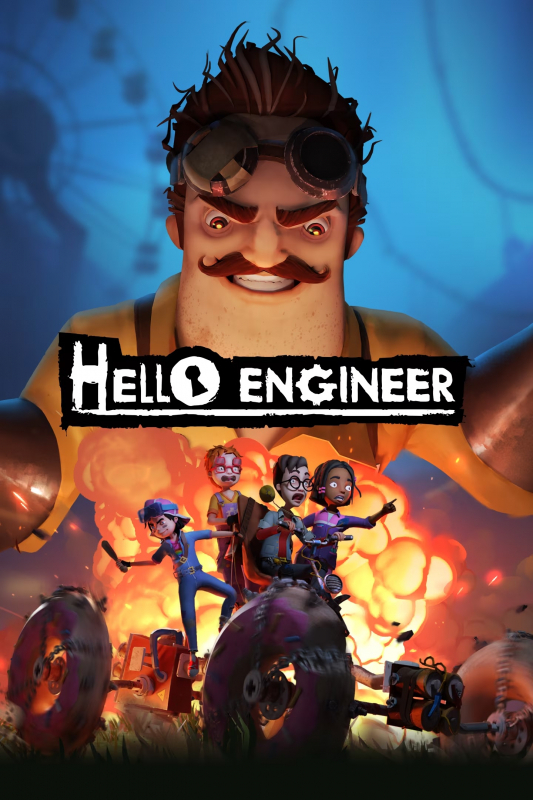Existing User Log In
New User Registration
Register for a free account to gain full access to the VGChartz Network and join our thriving community.





America - Front


America - Back

TinyBuild Games
Simulation
 (Add Date)
(Add Date) (Add Date)
(Add Date) (Add Date)
(Add Date)
| Owners: | 0 |
| Favorite: | 0 |
| Tracked: | 0 |
| Wishlist: | 0 |
| Now Playing: | 0 |
Another day, another former Stadia exclusive finally plopping onto console storefronts (I was incorrect to assume GYLT was the last). Beyond just its limited format, what makes this unassuming entry in the Hello Neighbor series somewhat intriguing is its diversion from the norm: it's a vehicular-construction game. Normally, taking an IP to a new genre is done after creating meaningful waves within its initial field; then again, this isn't the typical franchise. Given the mainline entries' tarnished standing on anything to do with stealth or adventure, perhaps tinyBuild Riga's Hello Engineer could go a long way in building up said reputation.
Engineer's story is more akin to context filler than a structured narrative. While hanging out at their van-turned-home-base, a squad of pre-teens happen upon an abandoned amusement park of sorts. When he's not getting away with kidnapping random strangers, Mr. Peterson frequents this ramshackle property for some unbeknownst reason. To learn – and hopefully thwart – whatever nefarious schemes he has in store, you must complete a set list of levels to progress forward.
Here, moving ahead is wholly reliant on your building acumen rather than quick reactions. What starts out simple with focusing on Engineer's – rather poor – driving mechanics quickly builds to a fusion of vehicle-crafting to then reach a designated finish line. Each level will introduce some type of permutation, be it muddy ground or suspended scaffolding, which you'll have to account for when building out your car's frame, motor power, tires, and so on.
What lends genuine appeal to Engineer's design ethos is in delaying gratification. Sure, it sounds rather simple to confect an odd contraption made of cheap aluminum, especially on the heels of Tears of the Kingdom's exceptional binding mechanic; and yet, there’s more to it than clicking a few LEGO pieces together. Take an early objective for example: crafting a little buggy with a metal T-shaped pole that's needed to grind a suspended rail over pits. Because of height-limit obstacles, you'll never pass by welding that pole to stick upright; no, you have to also craft a mechanical arm that goes up and down too. All of these components, from the correctly-attached struts to proper wiring, have to be completed at the starting gate. Once out on the track, it's up to you to test-run and potentially iterate on any necessary tweaks.
In theory, that sounds like a pleasant idea for a spin-off. Hell, given today's glut of reused templates, I welcome more diversions akin to Banjo-Kazooie: Nuts & Bolts. It makes even more sense when a series' original template is considered bottom of the barrel. Although this construction system has sound fundamentals, it's without nagging drawbacks. The main complaint against its finicky nature would be what's I'll call a "user-pinpoint engineering system." Usually, most work relies on the computer automatically snapping attachments to an ideal spot; here, more rides on you selecting said part – say a claw device for example – by its endpoint and placing it exactly where you want it on front of the frame. The build preview UI goes berserk if you’re not surgical with attachments. Specificity is one thing, but there's a breaking point when roughly one-third of accumulated building time stems back to fighting these underlying systems and a lousy sense of movement.
Construction can be aggravating, but it's a mere footnote to my apoplectic rage over the terrible vehicle physics. Attending an Alabama wedding has more appeal than replaying these short courses for a better track record. Granted, one defense about its driving locomotion will call on other titles like Fall Guys or Human: Fall Flat; after all, we're talking about cast iron motors glued onto a thin metal frame. By those generous standards, it still feels kinaesthetically dreadful to move around. Maneuvering simply doesn't feel right, as though the wheels will sporadically decide to stop gripping a course's surface. Regardless of wheel type, weight displacement, or any other considerations, something about its locomotion will always feel off-putting.
Which is a shame because, under better circumstances, it'd be easier to appreciate the better design elements. On top of giving increasingly tougher tasks, tinyBuild succeeds at encouraging heuristic discoveries alongside them. The early comfort of explicit blueprints (written on a big board) and video tutorials give way to vaguer rules, encouraging more experimentation through trial 'n error. While there are only two other background themes aside from a dense forest, at least each of them has some unique character. Similarly, there isn't an insane plethora of customizable vehicular options past what's necessary to move ahead; that said, the modest amount does lend enough creativity if you're willing to put in the time and effort.
Said time and effort can also be spent with up to three other players in multiplayer too. The only problem is I have no direct experience with it. Whether waiting in the main lobby or doing standard crafting in its sandbox mode, no one else ever appeared. I'll admit I wasn't waiting for days on end hoping to run into someone; that said, it would be helpful if multiplayer actually had formal lobbies. As far as I could tell, it's like people go into a pool and friends can join via invite. There isn't even the basic guts of a traditional online game, like segmented time zones or UI feedback. It's just a main menu option you select to join a ghost town.
These issues and more could be partially ameliorated by the $15 asking price. Given past Hello Neighbor’s entries being wildly overvalued, it's nice to strictly focus on a modest Unity title with no supplementary DLC nor micro-transactions. On top of the series' penchant for "discount Illumination" art design and nonsense-English spelling, Engineer's limited budget is readily apparent from its scant cut scenes and more; that said, it's made up with some nice locales and a serviceable soundtrack. It does enough to capture an appropriate mood: the blueprint skeleton when grabbing something, the simplistic color grading of commonplace parts, and more succeed in tacitly informing the player. Hell, part of my belabored moaning over physically constructing a vehicle is because of how easily each component can be visually understood; there's this disconnect between the final result I can quickly see through my mind's eye and the slog to reach it.
As a series, Hello Neighbor's modus operandi can be seemingly summed up like this: sell a neat concept and then utterly fumble the execution. Hello Engineer sticks to that script, but at least with a dash of panache and actual craftsmanship. Who can blame them for trying a lateral to a less-popular genre too? But when you get past that narrative, tinyBuild Riga's foibles highlight a lack of polish spoiling its otherwise good intentions. In other words: it has a functional chassis on four wheels... before hitting the first pothole.
Contractor by trade and writer by hobby, Lee's obnoxious criticisms have found a way to be featured across several gaming sites: N4G, VGChartz, Gaming Nexus, DarkStation, and TechRaptor! He started gaming in the mid-90s and has had the privilege in playing many games across a plethora of platforms. Reader warning: each click given to his articles only helps to inflate his Texas-sized ego. Proceed with caution.









